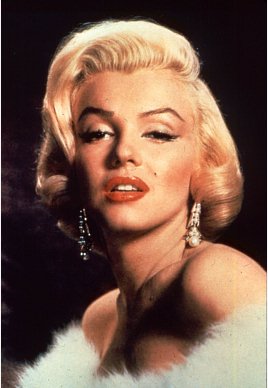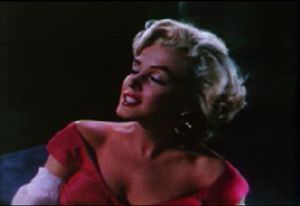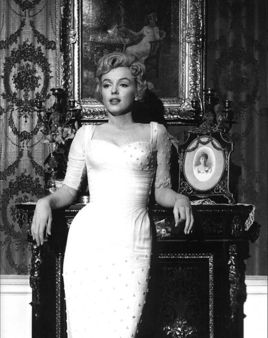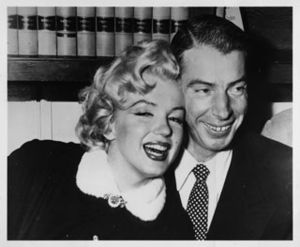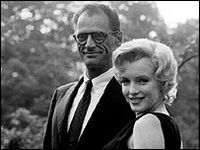Marilyn Monroe
| Marilyn Monroe | Biography Information | Physical Description | Professional Data | |||||||||||||||||||||||||||
|---|---|---|---|---|---|---|---|---|---|---|---|---|---|---|---|---|---|---|---|---|---|---|---|---|---|---|---|---|---|---|
|
|
| ||||||||||||||||||||||||||||
Click here for Pin-up girl page |
Click here for Movie Star category page |
Click here for Category:YANK magazine pinups |
- This article is about a Actress and model
Marilyn Monroe (born Norma Jeane Mortenson; ✦June 1, 1926 – †August 5, 1962), was a Golden Globe award winning American actress, model, Hollywood icon, and sex symbol. She was known for her comedic skills and screen presence becoming one of the most popular movie stars of the 1950s and early 1960s. During the later stages of her career, she worked towards serious roles with a measure of success and her fame surpassed that of any other entertainer of her time. However, she faced disappointments in her career and personal life during her later years. Her premature death was classified as a probable suicide. Conspiracy theorists speculate that she was murdered. She is #9 on the Forbes top earning dead celebrities list.
Childhood
Family and early life
Marilyn Monroe was born Norma Jeane Mortenson in the charity ward of the Los Angeles County Hospital. According to biographer Fred Lawrence Guiles, her grandmother, Della Monroe Grainger, had her baptized Norma Jeane Baker by Aimee Semple McPherson. She would not legally change her name to Marilyn Monroe until 1956.
Her mother was Gladys Pearl Monroe. Monroe's birth father was never identified. For many years it was believed Gladys' second husband Martin Edward Mortenson (1897-1981) was Monroe's father; due to his name being listed on her birth certificate. However this has been disputed with Monroe herself believing a salesman named Charles Stanley Gifford was her father. Whoever the father was he played no role in Monroe's life.
Foster homes
Mentally unstable and unable to care for Monroe, Gladys placed her with foster parents Albert and Ida Bolender of Hawthorne, California, where she lived until she was seven. In her autobiography My Story, Monroe states she thought Albert was a girl.
One day, Gladys announced that she had bought a house. A few months after they had moved in, Gladys suffered a breakdown. In My Story, Monroe recalls her mother "screaming and laughing" as she was forcibly removed to the State Hospital in Norwalk. According to My Sister Marilyn, Gladys's brother, Marion, hanged himself upon his release from an asylum, and Della's father did the same in a fit of depression.
Norma Jeane was declared a ward of state, and Gladys' best friend, Grace McKee (later Goddard) became her guardian. After McKee married in 1935, Norma Jeane was sent to the Los Angeles Orphans Home (later renamed Hollygrove), and then to a succession of foster homes.
The Goddards were about to move to the east coast and could not take Monroe. Grace approached the mother of a neighbor boy, James Dougherty about the possibility of her son marrying the girl. They married weeks after she turned 16, so that Norma Jeane would not have to return to an orphanage or foster care. Monroe stated in her autobiography that she did not feel like a wife; instead she enjoyed playing with the neighborhood children until her husband would call her home for the evening. The marriage would last until 1946 when Monroe decided to pursue her career.
Career
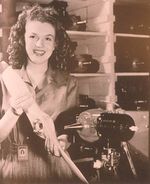
While her husband was in the Merchant Marine during World War II, Norma Jeane Dougherty moved in with her mother-in-law where she started working in the Radioplane Company factory owned by Hollywood actor Reginald Denny. Her job required spraying airplane parts with fire retardant and inspecting parachutes. Army photographer David Conover was scouting local factories, taking photos for a YANK magazine article about women contributing to the war effort. He saw her potential as a model, and she was soon signed by The Blue Book modeling agency. Shortly after signing with the agency, Monroe had her hair cut, straightened, and lightened to golden blonde. She soon began researching actresses, enrolling in drama classes, and singing classes.
She became one of Blue Book's most successful models, appearing on dozens of magazine covers. In 1946, she came to the attention of talent scout Ben Lyon. He arranged a screen test for her with 20th Century Fox. She was offered a standard six-month contract with a starting salary of $125 per week.
Lyon suggested she adopt Marilyn (after the famous actress Marilyn Miller) as her stage name, since Norma Jeane was not considered commercial enough. For her last name, she took her mother's maiden name. Thus, the 20-year-old Norma Jeane Baker became Marilyn Monroe. During her first six months at Fox, Monroe was given no work, but Fox renewed her contract and she was given minor appearances in Scudda Hoo! Scudda Hay! and Dangerous Years, both released in 1947. In Scudda Hoo!, her part was edited out of the film except for a quick glimpse of her face when she speaks two words. Fox decided not to renew her contract again. Monroe returned to modeling and began to network and make contacts in Hollywood. During this time is when she posed for nude photographs which would later be featured in the first issue of Playboy.
In 1948, during a six-month stint at Columbia Pictures, she starred in Ladies of the Chorus. However the low-budget musical was not a success and Monroe was dropped yet again. She then met one of Hollywood's top agents, Johnny Hyde, who had Fox re-sign her after MGM turned her down. Darryl F. Zanuck, the vice-president of Fox, was not convinced of Monroe's potential, but because of Hyde's persistence, she gained supporting parts in the Marx Brothers film Love Happy (1949), and in Fox's All About Eve and MGM's The Asphalt Jungle (both 1950). Even though the roles were small, moviegoers as well as critics took notice. Hyde also arranged for her to have minor plastic surgery on her nose and chin, adding that to earlier dental surgery.
Monroe proved she could carry a big-budget film when she starred in Niagara in 1953. Movie critics focused on Monroe's connection with the camera as much as on the sinister plot. She played an unbalanced woman planning to murder her husband. The next two years were filled with inconsequential roles in standard fare such as We're Not Married! and Love Nest. However, RKO executives used her to boost box office potential of the Fritz Lang production Clash by Night. After the film performed well, Fox employed a similar tactic, and she was cast as the ditzy receptionist with Cary Grant and Ginger Rogers in Howard Hawks's slapstick comedy Monkey Business. Critics no longer ignored her, and both films' success at the box office was partly attributed to Monroe's growing popularity.
Fox finally gave her a starring role in 1952 with Don't Bother to Knock, in which she portrayed a deranged babysitter who attacks the little girl in her care. It was a cheaply made B-movie, and although the reviews were mixed, they claimed that it demonstrated Monroe's ability and confirmed that she was ready for more leading roles. Her performance in the film has since been noted as one of the finest of her career.
Stardom
| Marilyn Monroe | ||
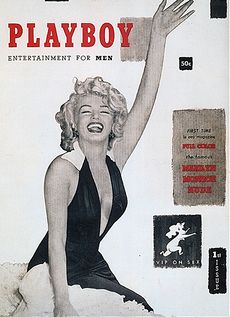
| ||
| Preceded by: | This was Premier issue | |
| Followed by: | Margie Harrison | |
| Also known as: | Norma Jeane Baker | |
| Birthdate: | Jun 1, 1926 | |
| Birthplace: | Los Angeles, CA | |
| Measurements: | 35C-22-35 in (88C-55-88 cm) | |
| Height: | 5' 5" (1.65m) | |
| Weight: | 115 lbs (52 kg) | |
First issue of Playboy, featuring a black-and-white photo of Monroe (in a dress) promising inside full-color pictures of her nude.Around this time, the nude photos of Monroe began to surface, taken by photographer Tom Kelley during her unemployment. Prints were bought by Hugh Hefner and, in December 1953, appeared in the first edition of Playboy. To the dismay of Fox, Monroe decided to publicly admit it was indeed her in the pictures. When a journalist asked her what she wore in bed she replied, "Chanel no.5". When asked what she had on during the photo shoot, she replied, "The radio".
Over the following months, Gentlemen Prefer Blondes and How to Marry a Millionaire cemented Monroe's status as an A-list actress, and she became one of the world's biggest movie stars. The lavish Technicolor comedy films established Monroe's "dumb blonde" on-screen persona.
In Gentlemen Prefer Blondes, Monroe's turn as gold-digging showgirl Lorelei Lee won her rave reviews, and the scene where she sang "Diamonds Are a Girl's Best Friend" has inspired the likes of Madonna, Kylie Minogue and Geri Halliwell. In the Los Angeles premiere of the film, Monroe and co-star Jane Russell pressed their foot- and handprints in the cement in the forecourt of Grauman's Chinese Theatre.
In How to Marry a Millionaire, Monroe was teamed up with Lauren Bacall and Betty Grable. She played a short-sighted dumb blonde, and even though the role was stereotypical, critics took note of her comedic timing.
Her next two films, the western River of No Return and the musical There's No Business Like Show Business, were not successful. Monroe tired of the roles that Zanuck assigned her. After completing work on The Seven Year Itch in early 1955, she broke her contract and fled Hollywood to study acting with Lee Strasberg at the Actors Studio in New York. Fox would not accede to her contract demands and insisted she return to work on productions she considered inappropriate, such as The Girl in Pink Tights (which was never filmed), The Girl in the Red Velvet Swing, and How to Be Very, Very Popular.
Once in New York Monroe set up her own production company Maryiln Monroe Productions with fashion photographer Milton H. Greene. She told a press conference she had set up the production company 'so I can play the better kind of roles I want to play.
As The Seven Year Itch raced to the top of the box office in the summer of 1955, and with Fox starlets Jayne Mansfield and Sheree North failing to click with audiences, Zanuck admitted defeat and Monroe returned to Hollywood. A new contract was drawn up, giving Monroe approval of the director as well as the option to act in other studios' projects.
The first film to be made under the contract and production company was Bus Stop, directed by Joshua Logan. She played Chérie, a saloon bar singer who falls in love with a cowboy. Monroe deliberately appeared badly made-up and unglamorous. She was nominated for a Golden Globe for the performance and was praised by critics. Bosley Crowther of The New York Times proclaimed: "Hold on to your chairs, everybody, and get set for a rattling surprise. Marilyn Monroe has finally proved herself an actress." In his autobiography, Movie Stars, Real People and Me, director Joshua Logan wrote: "I found Marilyn to be one of the great talents of all time... She struck me as being a much brighter person than I had ever imagined, and I think that was the first time I learned that intelligence and, yes brilliance have nothing to do with education."
The second movie filmed under her production company was The Prince and the Showgirl starring Laurence Olivier. Olivier praised Monroe's performance by saying she was, "a brilliant comedienne, which to me means she is also an extremely skilled actress" However Olivier became furious at her habit of being late to the set, as well as her dependency on her drama coach, Paula Strasberg. Monroe's performance was hailed by critics, especially in Europe, where she was handed the David di Donatello, the Italian equivalent of the Academy Award, as well as the French Crystal Star Award. She was also nominated for the British BAFTA award.
[[Image:MMonroe.jpg|thumb|Photo by Bruno Bernard
Later years
In 1959, she scored the biggest hit of her career starring alongside Jack Lemmon and Tony Curtis in Billy Wilder's Some Like It Hot. After shooting finished, Wilder publicly blasted Monroe for her difficult on-set behavior. Soon, however, Wilder's attitude softened, and he hailed her as a great comedienne. Some Like It Hot is consistently rated as one of the best films ever made. Monroe's performance earned her a Golden Globe for best actress in musical or comedy.
After Some Like It Hot, Monroe shot Let's Make Love directed by George Cukor and co-starring Yves Montand. Monroe was forced to shoot the picture because of her obligations to Twentieth Century-Fox. While the film was not a commercial or critical success, it included one of Monroe's legendary musical numbers, Cole Porter's "My Heart Belongs to Daddy".
Arthur Miller wrote what became her and her co-star Clark Gable's last completed film, The Misfits. The exhausting shoot took place in the hot Nevada desert. Monroe, Gable and Montgomery Clift delivered performances that are considered excellent by contemporary movie critics. Tabloid magazines blamed Clark Gable's death of a heart attack on Monroe, claiming she had given him a hard time on the set. Gable, however, insisted on doing his own stunts and was a heavy smoker. After Gable's death, Monroe attended the baptism of his son.
In 1961 some of the most famous photographs of Monroe were taken by Douglas Kirkland as a feature for the 25th anniversary issue of LOOK magazine.
Monroe returned to Hollywood to resume filming on the George Cukor comedy Something's Got to Give, a never-finished film that has become legendary for problems on the set and proved a costly debacle for Fox. In May 1962, she made her last significant public appearance, singing Happy Birthday, Mr. President at a televised birthday party for President John F. Kennedy.
After shooting what was claimed to have been the first ever nude scene by a major motion picture actress, Monroe's attendance on the set became even more erratic. On June 1, her thirty-sixth birthday, she attended a charity event at Dodger Stadium.
Financially strained by the production costs of Cleopatra, starring Elizabeth Taylor, Fox dropped Monroe from the film and replaced her with Lee Remick. However, co-star Dean Martin, who had a clause in his contract giving him an approval over his co-star, was unwilling to work with anyone but Monroe. She was rehired.
Monroe conducted a lengthy interview with Life, in which she expressed how bitter she was about Hollywood labeling her as a dumb blonde and how much she loved her audience. She also did a photo shoot for Vogue and began discussing a future film project with Gene Kelly and Frank Sinatra, according to the Donald Spoto biography.
She was planning to star in a biopic of Jean Harlow as well as starring alongside Jack Lemmon in Irma La Douce, a Billy Wilder comedy that eventually starred Shirley MacLaine. Other projects under consideration were What a Way to Go! (in which Shirley MacLaine replaced her), Kiss Me, Stupid, a comedy starring Dean Martin and Kim Novak, and a musical version of A Tree Grows In Brooklyn.
Before the shooting of Something's Got to Give resumed, Monroe was found dead in her Los Angeles home on the morning of August 5, 1962. She remains one of the 20th century's legendary public figures and archetypal Hollywood movie stars.
Personal Life
Monroe's family had a history of mental illness and it is likely she suffered some effects of this. Monroe claimed to have been molested as a child though critics did not believe this. Her childhood did affect her; she was constantly late in everyday life as well as on set and at times others actors perceived her as nervous and insecure.
Her mental issues may have contributed to addictions as well. Close friends claim she was an alcoholic. In addition she was addicted to sleeping pills.
Monroe was seen as a sex symbol though she did not see this of herself. Monroe claims before her fame several men had proposed to her and a police officer had broken into her house. During an acting exercise with Strasburg he stopped her, much to Monroe's confusion, believing she was too sexually excited to continue. According to him she 'vibrated' sexuality.<ref>Monroe, Marilyn, My Story
Monroe yearned to be perceived as intelligent. She never graduated high school which made her insecure. She had a great love of reading and studying. Though baptized in the Christian faith Monroe was not religious. However she did convert to Judaism for her marriage to Arthur Miller though it is not known if she was devout.
Marriages and Relationships
James Dougherty
Monroe married James Dougherty on June 19, 1942. In The Secret Happiness of Marilyn Monroe and To Norma Jeane with Love, Jimmie, he claimed they were in love, but dreams of stardom lured her away. In 1953 he wrote a piece called "Marilyn Monroe Was My Wife" for Photoplay, in which he claimed that he left her.
In the 2004 ocumentary Marilyn's Man, Dougherty made three new claims: he was her Svengali and invented the "Marilyn Monroe" persona, studio executives forced her to divorce him, and that he was her only true love.
He remarried in 1947. The August 6, 1962 New York Times reported that, on being informed of her death, he replied "I'm sorry," and continued his Los Angeles Police Department patrol. He did not attend Monroe's funeral.
His sister wrote in the December 1952 Modern Screen Magazine that Dougherty left Monroe because she wanted to pursue modeling. He admitted to A&E Network that his mother asked him to marry her and told Lifetime Television in 1996 that he cut off her allotment after being served with divorce papers.
Joe DiMaggio
In 1951, Joe DiMaggio saw a picture of Monroe with two Chicago White Sox players but did not ask the man who arranged the stunt to set up a date until 1952. She wrote in My Story that she did not want to meet him, fearing a stereotypical jock. They eloped at San Francisco's City Hall on January 14, 1954. During their honeymoon, they visited Japan, and she was asked to visit Korea. She performed ten shows over four days in freezing temperatures for over 100,000 servicemen. Biographers have noted that DiMaggio, who stayed in Japan, was not pleased with his wife's decision during what he wanted to be an intimate trip.
Back home, she wrote him a letter about her dreams for their future, dated February 28, 1954:
- "My Dad, I don't know how to tell you just how much I miss you. I love you till my heart could burst... I want to just be where you are and be just what you want me to be... I want someday for you to be proud of me as a person and as your wife and as the mother of the rest of your children (two at least! I've decided)..."
DiMaggio biographer Maury Allen quoted New York Yankees PR man Arthur Richman that DiMaggio told him everything went wrong from the trip to Japan on. On September 14, 1954, Monroe filmed the iconic skirt-blowing scene for The Seven Year Itch in front of New York's Trans-Lux Theater. Bill Kobrin, then Fox's east coast correspondent, told the June 26, 2006 Palm Springs Desert Sun that it was Billy Wilder's idea to turn it into a media circus: "... every time her dress came up and the crowd started to get excited, DiMaggio just blew up." The couple later had a "yelling battle" in the theater lobby. She filed for divorce on grounds of mental cruelty 274 days after the wedding.
Years later, she turned to him for help. In February 1961, her psychiatrist arranged for her to be admitted to the Payne Whitney Psychiatric Clinic, where, according to Donald Spoto, she was placed in the ward for the most seriously disturbed. Unable to check herself out, she called DiMaggio, who secured her release. She later joined him in Florida. Their "just good friends" claim did not stop rumors of remarriage. Archive footage shows Bob Hope jokingly dedicating Academy Award for Best Song nominee The Second Time Around to them at the 1960 Academy Awards telecast. The two conceived a child, but it was stillborn.
According to Maury Allen, on August 1, 1962, DiMaggio — alarmed by how his ex-wife had fallen in with people such as Frank Sinatra and his "Rat Pack" — quit his job with a Army Post Exchange (PX} supplier to ask her to remarry him.
After her death, he claimed her body and arranged her funeral, barring Hollywood's elite. For 20 years, he had a dozen red roses delivered to her crypt three times a week. Unlike her other two husbands, he never talked about her publicly, wrote a tell-all, or remarried.
Arthur Miller
On June 29, 1956, Monroe married playwright Arthur Miller, whom she first met in 1951, in a civil ceremony in White Plains, New York. City Court Judge Seymour Robinowitz presided over the hushed ceremony in the law office of Sam Slavitt (the wedding had been kept secret from both the press and the public). In reflecting on his courtship of Monroe, Miller wrote, "She was a whirling light to me then, all paradox and enticing mystery, street-tough one moment, then lifted by a lyrical and poetic sensitivity that few retain past early adolescence". Nominally raised as a Christian , she converted to Judaism before marrying Miller. After she finished shooting The Prince and the Showgirl with Laurence Olivier, the couple returned to the United States from England and discovered she was pregnant. However, she suffered from endometriosis, and the pregnancy was found to be ectopic. A subsequent pregnancy ended in miscarriage.
Miller's screenplay for The Misfits, a story about a despairing divorcée, was meant to be a Valentine gift for his wife, but by the time filming started in 1960 their marriage was beyond repair. A Mexican divorce was granted on January 24, 1961. On February 17, 1962, Miller married Inge Morath, one of the Magnum photographers recording the making of The Misfits.
In January 1964, Miller's play After The Fall opened, featuring a beautiful and devouring shrew named Maggie. The similarities between Maggie and Monroe did not go unnoticed by audiences and critics (including Helen Hayes). Simone Signoret noted in her autobiography the morbidity of Miller and Elia Kazan resuming their professional association "over a casket". In interviews and in his autobiography, Miller insisted that Maggie was not based on Monroe. However, he never pretended that his last Broadway-bound work, Finishing the Picture, was not based on the making of The Misfits. He appeared in the documentary The Century of the Self lamenting the psychological work being done on her before her death.
The Kennedys
It has been claimed that Monroe was involved with either Robert Kennedy, John F. Kennedy, or both. Her close friend Jeannae Carmen claimed she had dated both, though she only loved Bobby. Carmen also believes at least one of the Kennedys was responsible for her death. However other friends disagree.
Death and aftermath
Monroe's last home was in Brentwood, Los Angeles, California. She was found dead by her housekeeper on August 5, 1962.
Her death was ruled to be "acute barbiturate poisoning" by Dr. Thomas Noguchi of the Los Angeles County Coroners office. (Noguchi also either performed or supervised on a range of celebrities that included Marilyn Monroe, Robert F. Kennedy, Janis Joplin, Albert Dekker, William Holden, John Belushi, Natalie Wood, and Sharon Tate.) Questions remain about the circumstances and timeline of housekeeper Eunice Murray's discovery of Monroe's body. Also, some conspiracy theories involve John and Robert Kennedy. The official cause of her death was "probable suicide".
On August 8, 1962, Monroe was interred in a crypt at Corridor of Memories, #24, at the Westwood Village Memorial Park Cemetery in Westwood, Los Angeles, California. Lee Strasberg delivered the eulogy.
Over 40 years after her death Forbes.com compiled a survey titled "Highest-Earning Dead Celebrities," which compared the money the celebrities' estates earn annually from sales. Monroe ranked 9th.
Administration of estate
In her will, Monroe left Lee Strasberg 75 percent of the residuary of the estate. She expressed her desire that Strasberg, or, if he predeceased her, her executor, "distribute [her personal effects] among my friends, colleagues and those to whom I am devoted."
Strasberg willed his portion to his widow, Anna. She declared she would never sell Monroe's personal items after successfully suing Odyssey Auctions in 1994 to prevent the sale of items which were withheld by Monroe's former business manager, Inez Melson. However, in October 1999 Christie's auctioned the bulk of the items Monroe willed to Strasberg, netting $12.3 million.
Anna Strasberg is currently in litigation against the children of four photographers to determine rights of publicity, which permits the licensing of images of deceased personages for commercial purposes. The decision as to whether Monroe was a resident of California, where she died, or New York, where her will was probated, is worth millions.
On May 4 2007, a federal judge in New York ruled that Monroe's rights of publicity ended upon her death, thus allowing the family of photographer Sam Shaw to sell photos of Monroe.
Quotes
- I think that when you are famous every weakness is exaggerated. (...) Goethe said, "Talent is developed in privacy," you know? And it's really true. (...) Creativity has got to start with humanity and when you're a human being, you feel, you suffer. You're gay, you're sick, you're nervous or whatever.
- Say goodbye to Pat, say goodbye to the president, and say goodbye to yourself, because you're a nice guy.[...]I'll see, I'll see.
- I don't know who invented high heels, but all women owe him a lot.
Pin-up Gallery
- Marilyn Monroe appeared in YANK magazine on 2 August, 1945
Filmography
| Year | Film | Role | Salary | Adjusted for inflation, rounded to two significant digits (2007) |
|---|---|---|---|---|
| 1947 | Dangerous Years | Evie | ||
| Scudda Hoo! Scudda Hay | Girl in canoe/Girl exiting church | $150/week | $1400/week | |
| Green Grass of Wyoming | ||||
| Ladies of the Chorus | Peggy Martin | |||
| 1949 | Love Happy | Grunion's client | ||
| 1950 | A Ticket to Tomahawk | Clara | ||
| The Asphalt Jungle | Angela Phinlay | $1,050 | $9,100 | |
| The Fireball | Polly | |||
| All About Eve | Miss Caswell | $500/week, with one-week guarantee | $4,300/week | |
| Right Cross | Dusky Ledoux | |||
| 1951 | Home Town Story | Iris Martin | ||
| As Young as You Feel | Harriet | |||
| Love Nest | Roberta 'Bobby' Stevens | |||
| Let's Make It Legal | Joyce Mannering | |||
| 1952 | Clash by Night | Peggy | ||
| We're Not Married! | Annabel Jones Norris | $750/week | $5,900/week | |
| Don't Bother to Knock | Nell Forbes | |||
| Monkey Business | Miss Lois Laurel | |||
| O. Henry's Full House | Streetwalker | |||
| 1953 | Niagara (1953} | Rose Loomis | ||
| Gentlemen Prefer Blondes | Lorelei Lee | $1,250/week | $9800/week | |
| How to Marry a Millionaire | Pola Debevoise | |||
| 1954 | River of No Return | Kay Weston | ||
| There's No Business Like Show Business | Vicky Hoffman/Vicky Parker | |||
| 1955 | The Seven Year Itch | The Girl | $1,500/week | $12,000/week |
| 1956 | Bus Stop | Cherie | ||
| 1957 | The Prince and the Showgirl | Elsie Marina | ||
| 1959 | Some Like It Hot | Sugar Cane Kowalczyk | $200,000 plus 10% gross over $4 million | $1,400,000 +10% gross over $29m |
| 1960 | Let's Make Love | Amanda Dell | ||
| 1961 | The Misfits | Roslyn Taber | $250,000 | $1,700,000 |
| 1962 | Something's Got to Give | Ellen Wagstaff Arden | $100,000 | $690,000 |
Awards and nominations
- 1952 Photoplay Award: Special Award
- 1953 Golden Globe Henrietta Award: World Film Favorite Female.
- 1953 Photoplay Award: Most Popular Female Star
- 1956 British Academy of Film and Television Arts (BAFTA) Film Award nomination: Best Foreign Actress for The Seven Year Itch
- 1956 Golden Globe nomination: Best Motion Picture Actress in Comedy or Musical for Bus Stop
- 1958 BAFTA Film Award nomination: Best Foreign Actress for The Prince and the Showgirl
- 1958 David di Donatello Award (Italian): Best Foreign Actress for The Prince and the Showgirl
- 1959 Crystal Star Award (French): Best Foreign Actress for The Prince and the Showgirl
- 1960 Golden Globe, Best Motion Picture Actress in Comedy or Musical for Some Like It Hot
- 1962 Golden Globe, World Film Favorite: Female
- Star on the Hollywood Walk of Fame 6104 Hollywood Blvd.
- 1999 she was ranked as the sixth greatest female star of all time by the American Film Institute in their list AFI's 100 Years... 100 Stars.
See also
- Death of Marilyn Monroe @ WP
- Marilyn Monroe in popular culture @ WP
- Berniece Baker Miracle @ WP, her half-sister
- Look alike contest @ WP Monroe's popularity as a costume
- Mark Bellinghaus @ WP Monroe memorabilia collector and activist
Notes
References
- American Monroe: The Making of a Body Politic, S. Paige Baty < ISBN:0-520-08806-9 Buy it from Amazon.com > Examines Monroe's stature as an icon.
- Marilyn Monroe and the Camera, Georges Belmont < ISBN:3-8238-5467-4 Buy it from Amazon.com > Monroe's "love affair" with the camera.
- The Many Lives of Marilyn Monroe| publisher, Sarah Churchill < ISBN:0-8050-7818-5 Buy it from Amazon.com > Explores Western Civilization's fixation with Monroe.
- The Ultimate Marilyn, Ernest W. Cunningham, < ISBN:1-58063-003-0 Buy it from Amazon.com > A compendium of facts, fantasies and scandals about Marilyn Monroe.
- Inside Marilyn Monroe: A Memoir, John Gilmore < ISBN:0-9788968-0-7 Buy it from Amazon.com > Examination of Monroe's personal and professional life.
- Norma Jean: The Life of Marilyn Monroe, Fred Lawrence Guiles < ISBN:1-55778-583-X Buy it from Amazon.com > Reissue of a biography cited in this article.
- Marilyn: A Biography, Norman Mailer ISBN 0-448-01029-1 His controversial take on Monroe.
- My Sister Marilyn, Berniece Baker Miracle and Mona Raw Baker. < ISBN:1565120701 Buy it from Amazon.com >
- My Story, Marilyn Monroe < ISBN:0-8154-1102-2 Buy it from Amazon.com > Reprint of her memoirs, ghost-written by Ben Hecht; introduction by Andrea Dworkin.
- Marilyn Monroe: A Life of the Actress, Carl E. Rollyson < ISBN:0-306-80542-1 Buy it from Amazon.com > Scholarly look at her films.
- Marilyn Monroe: The Biography, Donald Spoto < ISBN:0-8154-1183-9 Buy it from Amazon.com > Biography cited in this article.
- Marilyn's Last Words: Her Secret Tapes and Mysterious Death, Matthem Smith < ISBN:0-7867-1380-1 Buy it from Amazon.com > Alleged transcripts of Monroe's therapy sessions.
- Marilyn in Art, Roger G. Taylor < ISBN:1-904957-02-1 Buy it from Amazon.com > Examines Monroe's influence on numerous artists.
- Vitacco-Robles, Gary (2003). Cursum Perficio: Marilyn Monroe's Brentwood Hacienda: The Story of Her Final Months. IUniverse. ISBN 0-595-01082-2
- The Complete Marilyn Monroe, Adam Victor < ISBN:0-500-01978-9 Buy it from Amazon.com >
- Marilyn: Norma Jeane, Gloria Steinem photos by George Barris. < ISBN:0451155963 Buy it from Amazon.com >
External links
Sanity check 10/24-2019 R/
- Also see the Wikipedia page [ Marilyn Monroe ]
- Marilyn Monroe at the Internet Movie Database
- Marilyn Monroe at the Turner Classic Movie Database
- The Marilyn Monroe Collection
- Marilyn Remembered Fan Club
The Forever Marilyn Fan Club( X Site down 10/19 R/ )- Marilyn Monroe's 1952 interview with Parade
- Official website
- Virtual Tour of Marilyn Monroe's Brentwood Hacienda
- Marilyn Monroe's grave site
- Marilyn Monroe, Frank Sinatra, Joe DiMaggio and the 1954 "Wrong Door Raid."
- Images taken at Niagara Falls during the filming of the movie Niagara
Niagara Falls Public Library(Ont.) ( X Site down 10/19 R/ ) Marilyn Monroe Collectibles Feature( X Site down 10/19 R/ )- Married to Marilyn by Norman Mailer from The New York Review of Books
- Marilyn Monroe on NNDB.com - http://www.nndb.com/people/219/000022135/ ( X Site down )
What links here • References and Sources • Help • Contact info
